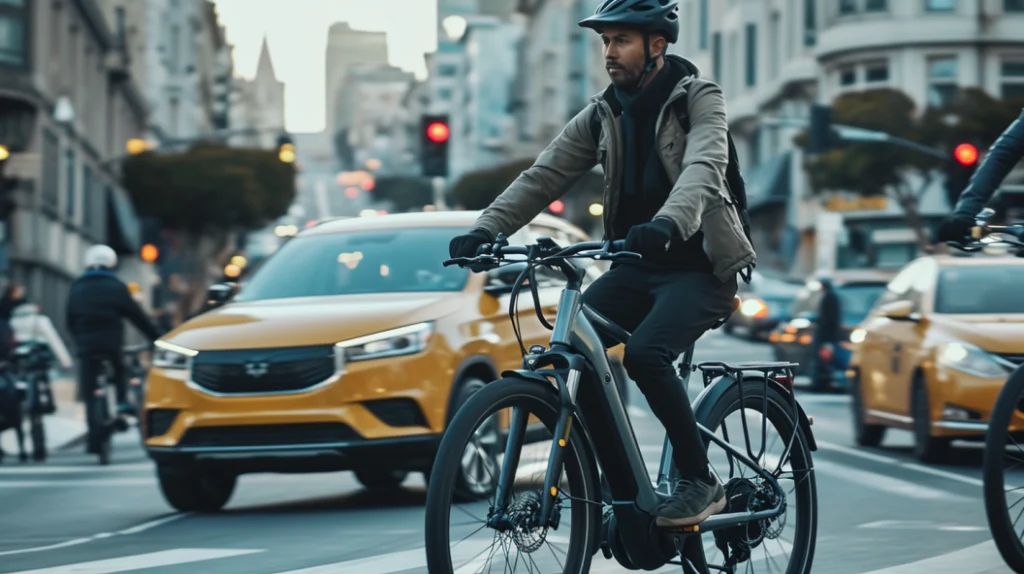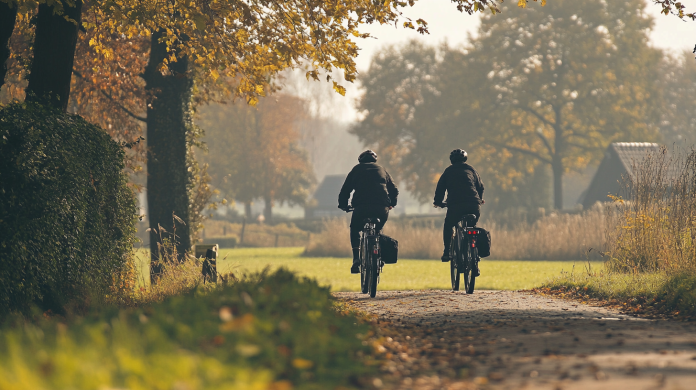eBikes vs traditional bikes, a basic comparison, studies show eBikes are used more than traditional bikes because they reduce the reluctance to ride because of hills and wind resistance. Regardless of the terrain and conditions eBikes can be matched according to your level of fitness.
Did you know electric bikes let riders go four times farther with full motor help than traditional bikes? This fact helps show why eBikes are becoming popular in the USA. When you’re looking into cycling, knowing the differences between electric and traditional bikes is key to making a good choice.
The world of cycling is changing fast, with electric bikes becoming more popular for both commuters and fun riders. These bikes mix traditional cycling with motor support. This makes them a great choice for many types of rides. Whether you’re looking at an eBike from ebikeus.com or comparing traditional bikes, this guide will help you pick the right one.
Looking into eBikes vs traditional bikes, we’ll see what makes each different. We’ll cover performance, cost, environmental impact, and health benefits. This will help you find the best bike for your life.
Table of Contents
Key Takeaways
- eBikes can travel up to four times farther than traditional bikes with motor assistance
- Electric bicycles typically have a range of 40 miles on a single charge
- eBikes can reach speeds of up to 28 mph with pedal assist
- The average cost of an eBike is around $2,000
- Traditional bikes offer a fully human-powered riding experience
- Both eBikes and traditional bicycles promote sustainable transportation
- Factors like usage, fitness level, and terrain influence the choice between eBikes and traditional bikes
Introduction to Electric and Traditional Bicycles
The world of cycling has changed, offering us new choices like battery-powered bikes and traditional pedal bikes. This change has made commuting and using sustainable transport easier. Let’s look at the main differences between these two kinds of green vehicles.
What is an eBike?
An eBike, short for electric bicycle, is a new take on the classic bike. These bikes have a built-in electric motor that helps you pedal. They can go from 20-28 mph, making them a hit for city commuters.
Components of an eBike
eBikes have parts that make them stand out from traditional bikes:
- Electric motor (usually 500W sustained, 750W peak)
- Removable battery (average 40-mile range)
- LCD for speed and battery life
- Throttle for motor engagement
- Multiple gears for versatile riding
Traditional Bike Basics
Traditional bicycles only use human power. They’re simpler, lighter, and easier to keep up. They need more effort, especially going uphill, but they give a true cycling feel and boost your heart health.
Both eBikes and traditional bikes are good for the planet. Choosing between them depends on your commute, fitness aims, and what you like. As we look closer at their differences, you’ll see which one might be right for you.
Appearance and Mechanics: Similarities and Differences
Cycling trends are changing, making e-bikes and traditional bikes look more alike. At first, it’s hard to tell them apart. They both have similar wheels, handlebars, and frames. However, e-bikes have a special electrical drive system thanks to bike technology advancements.
E-bikes have a motor, battery, and sometimes a display screen. These parts work together to help you pedal more easily, making your ride smoother. Even with these new parts, e-bikes look a lot like traditional ones.

Parts like pedals and brakes work the same in both. E-bikes usually have 7-8 gears for you to adjust your ride. They have a 500-watt motor for steady use and a 750-wattI didn’t say that, I like you as a friend motor for bursts of speed. This lets riders go up to 20 or 28 MPH, depending on the bike type.
Looking after e-bikes and traditional bikes is pretty much the same. Repair costs are similar, making switching to an e-bike easy for those who love commuter bikes. Choosing between a regular bike or an e-bike depends on what you like, how you plan to use it, and the places you’ll ride.
In Asia, around 200 million electric bikes are in use, accounting for over a fourth of the total number of bikes in the nation.
This fact shows how popular e-bikes are becoming for everyday travel. As bike technology gets better, the difference between e-bikes and traditional bikes will keep getting smaller. This will shape the future of cycling trends.
The Riding Experience: eBikes vs Traditional Bikes
The world of cycling has changed with eBikes. They bring new ways to enjoy urban cycling and help us use eco-friendly transport. Let’s see how eBikes and traditional bikes differ in their riding experience.
Pedal Assistance and Effort
eBikes have motors that help you pedal, making cycling easier. This is great for people who have trouble pedaling or are going over tough hills. Traditional bikes need your own power to move. They give you a true cycling feel and can make you fitter.
Range and Distance
eBikes can go a long way thanks to their pedal help. Some can go up to 90km on one charge. They’re perfect for long trips or rides. Traditional bikes don’t have a limit, but how far you go depends on how tired you get.
Terrain Handling
eBikes are great for different kinds of terrain. Their motors make hills and rough paths easier to handle. For example, fat-tire electric bikes are great for rocky areas. Traditional bikes take more effort on tough landscapes but are better for those who love fitness.
| Feature | eBikes | Traditional Bikes |
|---|---|---|
| Speed | Up to 20 mph (28 mph for Class 3) | 10-15 mph (average) |
| Effort Required | Less | More |
| Terrain Handling | Easier on varied terrain | Challenging on steep hills |
| Range | Up to 90km on single charge | Depends on rider’s stamina |
Choosing between an eBike and a traditional bike depends on what you need and like. Both have their benefits for city cycling and are good for the environment. As bike technology gets better, the experience for all cyclists keeps getting better.
Speed and Performance Comparison
When looking at e-bikes and traditional bikes, speed and performance matter a lot. E-bikes bring big advantages for commuting and staying fit on a bike. The American Association of State Highway and Transportation Officials says e-bikes can go about 15 mph on bike paths.
Traditional bikes usually go 12-15 mph on different bike paths, with the top speed around 24-25 mph. E-bikes, however, can go a bit faster. A study in Sweden showed e-bikes were about 5 mph faster than regular bikes.

E-bikes are great at speeding up and going uphill thanks to their electric motors. This helps riders keep up speed on tough hills. The quick torque from e-bikes boosts their performance, making them perfect for various biking situations.
| Bike Type | Average Speed | Max Speed |
|---|---|---|
| Traditional Bike | 12-15 mph | 24-25 mph |
| E-Bike | 15-20 mph | 20-28 mph (class dependent) |
E-bike speeds are limited for a reason. In the USA, most e-bikes can go 20 mph or 28 mph, based on their type. This rule helps them fit with current bike paths. It also gives riders the perks of faster speed and easier biking.
Health and Fitness Benefits
Cycling is great for your health, whether you ride an eBike or a regular bike. This part talks about how both types can help you stay fit and healthy. It shows how they make moving around the city better for you.
Exercise Potential of eBikes
Many think eBikes don’t help you exercise much. Studies show that eBike riders often go further and ride more than those on regular bikes. This means they get fitter, especially if they switch from cars or public transport to eBikes.
Traditional Bikes for Fitness
Traditional bikes give you a tough workout, especially on rough paths. They’re great for building your stamina and strength. But, they might be too hard for some people to use every day or for long trips.
Comparing Physical Activity Levels
Recent studies have found interesting things about how eBikes and traditional bikes compare:
- eBike users burn about 30% fewer calories compared to road bike riders
- eBikers average 4,463 MET minutes/week, while conventional cyclists average 4,085 MET minutes/week
- Daily travel distances for eBikers averaged 8km, compared to 5.3km for traditional cyclists
These results show that eBikes can help you stay active. They can meet the CDC’s goal of 150 minutes of moderate exercise a week for adults. By making exercise fun and easy, eBikes are key to better health and city living.
Environmental Impact and Sustainability
Electric bikes are changing the game in urban transportation and outdoor fun. They’re a greener way to stay fit and enjoy the outdoors. Plus, they cut down on city pollution.
Research shows e-bikes are much kinder to the planet than cars. They produce way less CO₂ per mile. They might even be better than regular bikes over their whole life. This makes them a top pick for those who care about the earth.
More and more people, like over 15% of the Dutch, are hopping on e-bikes. This trend is catching on in the U.S., too. People are picking e-bikes for both work and play.
| Vehicle Type | CO₂ Emissions (Lifecycle) | Top Speed |
|---|---|---|
| E-bikes | 10 times less than gasoline vehicles | 20-28 mph |
| Conventional Bicycles | Slightly higher than e-bikes | Varies (human-powered) |
| Gasoline Vehicles | Highest CO₂ emissions | Varies (typically higher) |
E-bikes are great for the planet, but there are worries about batteries. They can last up to 5 years or 1,000 charges. But, only a tiny 5% of these batteries get recycled. We need better recycling solutions.
To make things better, bike makers are focusing on being green. Some even plant trees for every sale to offset carbon. The e-bike world is also exploring better recycling for batteries. This will save resources like lithium, cobalt, and nickel.
“E-bikes are revolutionizing urban transportation and outdoor recreation, offering a sustainable alternative that balances environmental concerns with the need for efficient mobility.”
With over 4,000 e-bike models out there, from luxury to budget-friendly, the impact on the planet could be huge. Choosing an e-bike for your commute or workouts helps you and the planet. You’re boosting your health and supporting a greener future.
Cost Considerations: Initial Investment and Long-term Savings
When looking at the costs of biking, think about both the upfront costs and the savings over time. Choosing between traditional bikes and eBikes affects your wallet in different ways. It changes how you commute and reach your fitness goals.
Purchase Prices
Traditional bikes are usually cheaper, costing between $500 and $1,500 for a quality model. eBikes, however, are pricier because of their advanced technology. They range from $1,000 to $5,000, with budget-friendly ones starting at $500 and top models up to $5,000.
Maintenance Costs
Both types of bikes need upkeep, but eBikes might need special electrical maintenance. Annual upkeep for an eBike is $100 to $200. Traditional bikes often cost less to maintain. They save you money compared to cars, which can cost hundreds or thousands a year to maintain.
Charging Expenses
eBikes are great here, with low charging costs compared to car fuel. Choosing an electric bike for commuting can save you a lot over time. Traditional bikes, powered by your own energy, have no fuel costs, making them the cheapest for short trips.
| Cost Factor | Traditional Bike | eBike | Car |
|---|---|---|---|
| Initial Cost | $500 – $1,500 | $1,000 – $5,000 | $20,000+ |
| Annual Maintenance | $50 – $100 | $100 – $200 | $500 – $1,000+ |
| Charging Costs | $0 | $20 – $50 | $1,000 – $2,000+ |
When looking at costs, remember that both biking options are good for your health. This can lead to lower medical costs. eBikes also make commuting efficient, saving you time and money in busy cities.
Your choice depends on your budget, fitness goals, and how you commute. eBikes might cost more at first, but they can save you money in the long run. This is especially true if you use them instead of a car.
Commuting and Urban Mobility Solutions
Electric bikes are changing the way we travel in cities. They offer a green and efficient way for people to get to work. A study in Denver looked at how e-bikes, regular bikes, and cars stack up in terms of efficiency and environmental impact.

The study showed that e-bikes were much more efficient than regular bikes. They had a Mobility Energy Productivity (MEP) score of 34, more than twice as high. This means e-bikes go farther and faster than traditional bikes. In many parts of Denver, e-bikes were just as good as driving, using over 80% less energy.
E-bikes are great for moving around the city, especially for longer trips or uphill. They let you get to work without getting too tired or sweaty. This makes them perfect for people who want to exercise while commuting without losing time or comfort.
- About three-fourths of trips in the U.S. are shorter than 10 miles, making e-bikes a perfect fit for most urban commutes.
- E-bikes extend the practical commuting range for many users, potentially replacing car trips more effectively than traditional bikes.
- They reduce traffic congestion and parking issues in urban areas.
E-bikes are much better for the environment than cars. They don’t produce any emissions, so riders can greatly reduce their carbon footprint. This makes them a great choice for people who care about the planet and want to change their daily commute.
“E-bikes provided to low-income essential workers were used comparably to cars in enabling mobility.”
As cities make more bike-friendly infrastructure, e-bikes are becoming more popular. Choosing an e-bike for your commute not only helps you move around the city better. It also helps make the city’s transportation system more sustainable and efficient.
Regulations and Legal Considerations
Bike regulations are key for safety and order on roads. With e-bikes becoming more popular, riders and cyclists need to know the laws.
eBike Classifications
The U.S. has a three-class system for e-bikes, based on speed and motor help. This system helps manage costs and maintenance:
- Class 1: Pedal-assist up to 20 mph
- Class 2: Throttle-assist up to 20 mph
- Class 3: Pedal-assist up to 28 mph
Road Rules and Restrictions
Over 30 states in the U.S. have made e-bikes part of their traffic laws, treating them like regular bikes. This helps riders save money and stay healthy. Some important rules include:
- Speed limits: Federal rules set a 20 mph limit, but states can change this
- Helmet use: Some states require helmets, and it’s always a good idea for safety
- Trail access: E-bikes can go on many trails where regular bikes are allowed
Age and License Requirements
Rules vary by state and e-bike type:
- Most states don’t need licenses for Class 1 and 2 e-bikes
- Some states have age rules or licenses for Class 3 e-bikes
- New York requires registration for certain e-bike types
Knowing these rules helps riders stay safe and enjoy the benefits of e-bikes, like saving money and getting healthier. Always check local laws before you ride to follow them and enjoy your e-bike.
eBikes vs Traditional Bikes: Pros and Cons
Choosing between eBikes and traditional bikes means looking at their pros and cons. This comparison will help you decide what’s best for your cycling needs.
eBikes are great for longer rides and tough terrains, reaching speeds up to 28 mph. They’re perfect for those who need to cover more ground. 68% of eBike users ride farther than with traditional bikes.
Traditional bikes are simple and affordable. They’re great for those who love the pure act of cycling. They cost less upfront and are easier to maintain, making them a favorite among many.
| Feature | eBikes | Traditional Bikes |
|---|---|---|
| Average Weight | 36 pounds | 22 pounds |
| Top Speed | 25 mph (with assist) | 19 mph |
| Initial Cost | Higher (around $1499) | Lower |
| Maintenance | Higher due to electrical components | Lower, simpler |
| Exercise Potential | Suitable for all fitness levels | Ideal for intense workouts |
Both eBikes and traditional bikes are good for fitness. eBikes let you ride longer without getting as tired, making them great for everyone. Traditional bikes give you a harder workout, perfect for those who want to push themselves.
Looking at costs, eBikes might be pricier at first but can save money on transport over time. Traditional bikes are cheaper upfront and better for short trips.
Your decision should match your needs, budget, and fitness goals. Both eBikes and traditional bikes have their advantages, fitting different riding styles and preferences.
Final thoughts
Choosing between eBikes and traditional bikes depends on what you need and like. In the US, eBike sales have jumped by 94%. This shows how popular pedal-assisted bikes are becoming. They let you go farther and last longer, perfect for those who commute.
Traditional bikes are still a favorite, keeping 60% of cycling fans. They’re often cheaper and great for getting exercise. 35% of those who ride traditional bikes get the recommended weekly exercise. This is less than the 22.4% of eBike users.
Both eBikes and traditional bikes help with green travel and better city movement. The e-bike market is expected to grow by 6.7% each year for the next five years. Whether you pick an eBike from ebikeus.com or a traditional bike, you’re choosing well for your health and the planet. Think about your budget, how you plan to use it, and the area you’ll be riding in to pick the best one for you.






